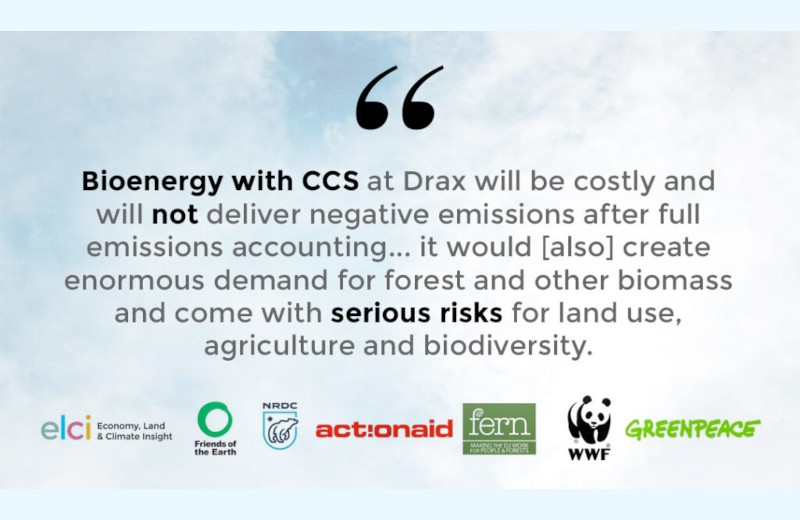This post is a reproduction of a letter sent to the UK Department for Business, Energy and Industrial Strategy in March 2021.
The undersigned groups oppose using public funds to support industrial scale biomass-burning with carbon capture and storage (BECCS) at Drax Power Station. Large government subsidies should deliver large climate benefits. Yet, evidence as described below, suggests that BECCS at Drax will be costly and will not deliver negative emissions after full emissions accounting for biomass in the power sector. At the same time, it would create enormous demand for forest and other biomass and come at serious risks for land use, agriculture and biodiversity in the UK and abroad.[i]
Drax does not properly account for carbon lost from harvesting and foregone sequestration.[ii] If it did, then even with CCS the overall impact is that it would produce electricity with greater carbon emissions than offshore wind.[iii] It would be inappropriate to use public funds to subsidise the development of BECCS and a pipeline to Drax when it will be worse for the climate than other low-carbon options (e.g. genuine renewables), and the company has already benefitted from large sums of direct public subsidies and avoided carbon tax liabilities.[iv] Any such programme will be ineffective in drawing down emissions and may result in diverting public resources better invested elsewhere.
Accounting for the carbon impacts of biomass harvest is complex; however, when done correctly, industrial scale biomass use for electricity is rarely carbon neutral.
BECCS relies on the premise that because forests and other plants absorb carbon as they grow, bioenergy is ‘carbon neutral.’ Proponents argue that when biomass is burned to fuel a power station, capturing and sequestering the smokestack CO2 emissions would thus make the process ‘carbon negative.’ However, as explained below, the evolving research on carbon accounting suggests that policymakers are overlooking a key technical factor in determining the net carbon impacts of biomass harvest for energy under BECCS.
Even without considering the large supply chain emissions in processing and transporting wood pellets, burning biomass for electricity increases emissions in three key places:
- First, biomass plants emit CO2 at the smokestack effectively transferring the harvested forest carbon into the atmosphere.[v]
- Second, biomass harvest in forests releases carbon from the soil.[vi]
- Third, on the landscape, replacing older trees with saplings after harvest reduces the amount of carbon stored in the re-growing forest, even under the best-case scenario in which trees are replanted and regrow immediately; the latter represents a separate and significant source of emissions, known as foregone sequestration.[vii]
Together, this means that forest biomass harvest for energy, even under BECCS, has a negative impact on the climate, with consequences that can persist for decades or more—far outside Paris Agreement timeframes.[viii] This holds true even under the industry’s definition of “sustainable” biomass sourcing of thinnings from managed forests.[ix]
To date, the third key aspect of carbon accounting, foregone sequestration, has been neglected in the UK and elsewhere.[x] But if it were included, the latest research strongly suggests that forest bioenergy, even with CCS, will in most cases be a carbon source rather than a carbon sink.[xi] While CCS can in theory capture and store smokestack emissions, it can never mitigate emissions from foregone sequestration, which are, in effect, long-term and ‘uncapturable’ in a BECCS scenario. Specifically, even assuming near complete capture of stack emissions, BECCS still can never eliminate the post-harvest degraded sequestration on the landscape. Thus, adding CCS to these plants does not result in negative emissions.
Biomass “sustainability” is not a proxy for climate benefits.
Proponents argue that so long as biomass is “sustainably sourced,” policymakers can assume it to be no-or low-carbon. Yet biomass sustainability claims are misleading and do not account for climate impacts.[xii] According to Drax, over 99.5% of the more than seven million metric tons of woody biomass burned annually at Drax Power Station comes from overseas forests.[xiii] Wood sourced using damaging logging practices, including clear-felling of mature and highly biodiverse hardwood forests, routinely enters the UK energy market.[xiv] This biomass is high-carbon and its sourcing contributes to forest degradation, yet it takes place under existing governmental and corporate sustainability standards.
Largescale biomass-burning for BECCS has serious implications for land use, agriculture and biodiversity in the UK, and may come at the expense of nature-based solutions.
According to the Committee on Climate Change, meeting biomass demand for BECCS with domestic sources would require converting UK cropland to grow energy crops.[xv] Reducing the land available for food production risks either greater intensification of agriculture or a reduction in agricultural output. If biomass production has to rely on agricultural intensification in combination with monoculture biomass plantations, it risks damaging biodiversity if forests are converted to plantations heavily reliant on agrochemicals. Further, producing bioenergy crops at the scale required to meet BECCS demand may not be the best use of land to generate negative emissions. Once the carbon costs of pesticide use, fertiliser use, harvesting and transportation are factored in, any climate mitigation that is realised may be lower than if the same land was used for another carbon-absorbing activity, such as native tree-planting.[xvi]
Drax is already a hugely expensive and inefficient source of power. All indications point to BECCS costing tens of billions for a technology that harms the climate and nature.
Drax is a very inefficient power station, burning the equivalent of 127% of the UK’s entire wood production each year yet meeting less than 0.8% of the UK’s primary energy demand.[xvii] Thus, for every ten trees cut down for burning, six are wasted on producing uncaptured heat. The UK has abundant sources of cheaper and cleaner energy and does not need Drax or other biopower stations.[xviii] Rather than prioritising additional subsidies to run BECCS at Drax, a high priority from a climate perspective would be to replace Drax and other industrial scale bioenergy with low-carbon renewables.
Ensuring a safe climate requires rapidly eliminating energy sector emissions and protecting and restoring natural carbon sinks.
Large scale biomass-burning at Drax and elsewhere also sacrifices genuine opportunities to remove atmospheric CO2 because it requires harvesting trees, whereas maximal CO2 removal is achieved by letting forests grow.[xix] Protecting and restoring natural carbon sinks, including forests, peatlands, grasslands and wetlands are the most effective and proven ways of sequestering carbon and are thus critical. In addition to pulling CO2 out of the air and storing it in organic materials, these approaches can secure food supplies, improve the resilience of ecosystems and communities, and enhance biodiversity.[xx]
Statement signed by:
ActionAid International
Biofuelwatch
Campaign against Climate Change
Dogwood Alliance
EcoNexus
Economy, Land and Climate Insight
Environmental Justice Foundation (UK)
ETC Group
Feedback Global
Fern
Friends of the Earth England, Wales and Northern Ireland
Friends of the Earth Scotland
Green Christian
Greenpeace
NRDC (Natural Resources Defense Council)
Southern Environmental Law Center (SELC)
Sustain: the alliance for better food and farming
Whale and Dolphin Conservation
WWF UK
[i] Heck, V., Gerten, D., Lucht, W. et al. Biomass-based negative emissions difficult to reconcile with planetary boundaries. Nature Climate Change 8, 151–155 (2018). https://doi.org/10.1038/s41558-017-0064-y; European Academies of Science Advisory Council, “Forest bioenergy, carbon capture and storage, and carbon dioxide removal: an update,” February, 2019,
[ii] Chatham House, “Woody Biomass for Power and Heat,” June 2018, https://www.chathamhouse.org/2018/06/woody-biomass-power-and-heat/accounting-biomass-carbon-emissions
[iii] Michael Norton et al., “Serious Mismatches Continue Between Science and Policy in Forest Bioenergy,” Global Change Biology Bioenergy 11, no. 11 (November 2019): 1256-1263, https://doi.org/10.1111/gcbb.12643.
[iv] Ember, “The Burning Question; Should the UK end tax breaks on burning wood for power?,” June, 2020, https://ember-climate.org/wp-content/uploads/2020/06/2020-Ember-Burning-question-FINAL.pdf
[v] European Academies’ Science Advisory Council, “Commentary by the European Academies’ Science Advisory Council (EASAC) on Forest Bioenergy and Carbon Neutrality,” June 15, 2018, According to the council, “Carbon emissions per unit of electricity generated from forest biomass are higher than from coal and thus it is inevitable that the initial impact of replacing coal with forest biomass in power stations is to increase atmospheric carbon dioxide levels.”
[vi] D. L. Achat et al., “Forest Soil Carbon Is Threatened by Intensive Biomass Harvesting,” Scientific Reports 5, art. 15991 (November 2015), https://www.nature. com/articles/srep15991. S. P. Hamburg et al., “Losses of Mineral Soil Carbon Largely Offset Biomass Accumulation 15 Years After Whole-Tree Harvest in a Northern Hardwood Forest,” Biogeochemistry 144, no. 1 (June 2019): 1-14, https://scholars.unh.edu/ersc/209/. E. D. Vance et al., “Environmental Implications of Harvesting Lower-Value Biomass in Forests,” Forest Ecology and Management 407 (January 2018): 47-56,
[vii] N. L. Stephenson et al., “Rate of Tree Carbon Accumulation Increases Continuously With Tree Size,” Nature, March 6, 2014, https://www.nature.com/articles/nature12914.
[viii] M. T. Ter-Mikaeilian, S. J. Colombo, and J. Chen, “The Burning Question: Does Forest Bioenergy Reduce Carbon Emissions? A Review of Common Misconceptions About Forest Carbon Accounting,” Journal of Forestry 11, no. 1 (January 2015): 57-68, Sami Yassa, “Think Wood Pellets Are Green? Think Again,” NRDC, May 2015, https://www.nrdc.org/sites/default/files/bioenergy-modelling-IB.pdf.
[ix] Spatial Informatics Group, The Carbon Impacts of UK Electricity Produced by Burning Wood Pellets from Drax’s Three U.S. Mills, May 27, 2019, https://www.southernenvironment.org/uploads/publications/2019-05-27_Drax_emissions_-_SIG_report_Phase_II.PDF
[x] Chatham House, “Woody Biomass for Power and Heat,” June 2018, https://www.chathamhouse.org/2018/06/woody-biomass-power-and-heat/accounting-biomass-carbon-emissions.
[xi] Searchinger et al 2009: Fixing a Critical Climate Accounting Error, http://www.sciencemag.org/content/326/5952/527.
[xii] “The Sustainable Biomass Program: Smokescreen for Forest Destruction and Corporate Non-Accountability,” NRDC and Dogwood Alliance, June 2017, https://www.nrdc.org/sites/default/files/sustainable-biomass-program-partnership-project-ip.pdf.
[xiii] Drax Group plc, 2019 Annual Report to Investors, https://www.drax.com/wp-content/uploads/2020/03/Drax_AR2019_Web.pdf
[xiv] “Global Markets for Biomass Energy are Devastating U.S. Forests,” NRDC, Dogwood Alliance and SELC, June 2019,
[xv] Committee on Climate Change, “Land Use: Policies for a Net Zero UK,” January 23, 2020
[xvi] Ember, “Gambling with Biomass: Reliance on BECCS undermines National Grid’s net-zero scenarios,” October 2020, https://ember-climate.org/commentary/2020/10/28/gambling-with-biomass/
[xvii] Total UK wood production in 2019 was 11.1 million tonnes: https://www.forestresearch.gov.uk/tools-and-resources/statistics/forestry-statistics/. At a 2:1 tonnes conversion, Drax burned equivalent of 14.1 million tonnes of green wood, generating 13.4 TWh of electricity: drax.com/wp-content/uploads/2020/03/Drax_AR2019_Web.pdf. The UK’s final energy demand in 2019 was 142.7 mtoe, equal to 1,659.6 TWh: gov.uk/government/statistics/electricity-chapter-5-digest-of-united-kingdom-energy-statistics-dukes.
[xviii] Vivid Economics, “Thermal generation and electricity system reliability,” June 2018, https://www.vivideconomics.com/casestudy/thermal-generation-and-electricity-system-reliability/.
[xix] Bronson W. Griscom, Justin Adams, et al. Proceedings of the National Academy of Sciences Oct 2017, 114 (44) 11645-11650; DOI: 10.1073/pnas.1710465114, https://www.pnas.org/content/114/44/11645
[xx] Kate Dooley, Doreen Stabinsky, “Missing Pathways to 1.5°C; The role of the land sector in ambitious climate action,” Climate Land Ambition and Rights Alliance,




